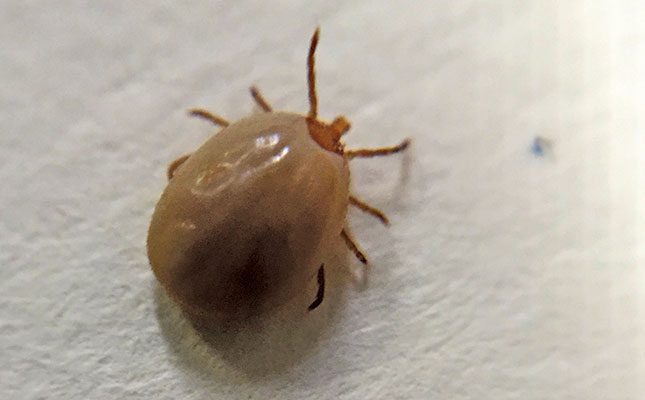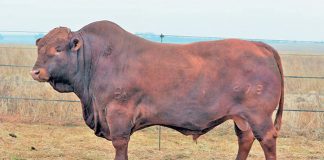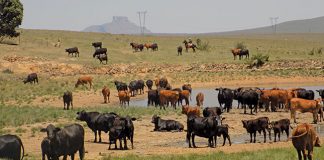
Photo: NIAID, Flickr
There are probably three different tick species within the sourveld tick group (Ixodes pilosus), of which only one has been described. The female is similar in appearance to the Karoo paralysis tick (Ixodes rubicundus), but the auriculae protrude laterally on the ventral side of the basis capituli, and there are spurs on the first pair of coxae.
The alloscutum bears four longitudinal rows of long, stout setae dorsally. The posterior alignment of the anal groove is short and converging. In the male, the genital aperture is present in an inverted U-shaped area formed by the ventral shields.
The sourveld tick is present in the south-eastern sourveld coastal regions of the Western and Eastern Cape, and around Nelspruit and near Polokwane. It is a three-host tick, with adults present in summer, larvae in autumn and nymphs in spring. This species is not known to transmit diseases.
All stages of development of I. pilosus infest cattle, sheep, dogs, grey rhebok, bushbuck, caracal and scrub hare. It attaches around the head.
Karoo paralysis tick
I. rubicundus is a strictly South African tick and has a reddish-brown colour. It can be found in the Karoo, southern Free State and in small areas near Bronkhorstspruit, Belfast and Heidelberg.
The presence of hilly or mountainous veld and of the wild olive tree (Olea europaea subsp. africana), the besembos shrub (Searsia erosa) and wire lemongrass (Elionurus muticus, or suurpol) all support the existence of the tick. The ticks also prefer the southern slopes of hills to the northern slopes, as the former are cooler.
Adults feed on sheep, goats, dogs, caracals, and mountain reedbuck. Immatures are found on rock elephant shrews, red rock rabbits and caracals. Females are present in the wool line on the limbs and bellies of sheep. Males rarely attach to host animals, but are frequently found attached to females.
This is a three-host tick. The females remain on the host for about seven days. They then detach, lay 2 000 to 4 000 eggs, and die.
The eggs ‘oversummer’ and only hatch the following autumn. The larvae feed on red rock rabbits and rock elephant shrews during autumn and winter, and the nymphs do so during winter and spring.
The engorged nymphs, which drop from these small mammals, ‘oversummer’ and moult to the adult stage the following autumn. The life cycle takes two years to complete. The eggs of this tick need humidity in order to hatch.
Adult ticks quest (lie in wait with front legs spread) on the grass at a height of about 40cm within 2m of besembos or wild olive trees. They react to vibrations, shadows and odours.
The questing height of the adults corresponds to the belly height of their hosts, mountain reedbuck and sheep.
Adults are most abundant on sheep and on antelopes during autumn to spring of one year. During the following year, larvae are most abundant on rock elephant shrews and on red rock rabbits during late summer to winter, and nymphs during winter to spring.
Adult ticks appear on the vegetation and on host animals earlier in the year in the south of South Africa than in the north.
The female ticks produce a toxin that causes paralysis, particularly in sheep and goats, but young calves and antelopes may also be affected. Peak numbers of adult ticks are present within four weeks of activity having commenced, and the number of female ticks per kilogram of host weight is important in the causation of paralysis.
Initially, paralysis of the legs is noted and may progress until paralysis of the respiratory system and death occurs. A few cases of paralysis may be seen in February or March, reaching a peak in April or May, and are associated with a drop in environmental temperature and with moist conditions.
If the ticks are removed timeously, the clinical signs are reversed within a few hours.
Spotting the Karoo paralysis tick
Its mouthparts are long relative to the size of the tick. The palps are club-shaped and denticles are visible on the lateral aspects of the hypostome. Eyes are absent. The legs are long and slender and appear to be grouped anteriorly. A prominent lateral groove is evident on the conscutum of the male and festoons are absent. The anal groove surrounds the anus anteriorly in both sexes.
The ventral surface of the male is covered with a number of shields and its genital aperture is present in an inverted V-shaped area formed by these shields. There are no adanal plates. The auriculae of the female do not protrude prominently laterally on the ventral aspect of the basis capituli, and the medioposterior aspect of the first pair of coxae is rounded and has no spur.
African blue tick
While the African blue tick (Rhipicephalus decoloratus) requires warmth and moisture, it is a fairly prominent tick throughout sub-Saharan Africa. In South Africa, it is found in the coastal regions of the Western and Eastern Cape, and throughout KwaZulu-Natal, Mpumalanga, Gauteng, Limpopo and North West and the eastern half of the Free State.
It is distributed through most of the wetter regions of South Africa, except for those localities at which it has been replaced by the Asian blue tick. However, it also occurs in cold mountainous areas such as the Drakensberg and parts of Lesotho.
The African blue tick is absent from the drier parts of South Africa, including the western Free State, the central Karoo, Bushmanland and Little Namaqualand. In Namibia, it is present only in localised areas in the north, and in Botswana it is restricted to the higher-rainfall eastern border areas and a few scattered localities in the north.
It is also present in the eastern half of Zimbabwe, Angola, much of Zambia, Malawi, south-western and northern Tanzania, Burundi, Uganda, western Kenya and in the wetter highlands and sub-highlands of Ethiopia. It is also found in most countries of sub-Saharan West Africa.
It is a one-host tick. Engorged females lay 1 000 to 2 500 eggs about one week after detaching from the host. These hatch in three to six weeks, and the larvae climb up vegetation and wait for a host. They attach, engorge and moult to the nymphal stage on the host after a week.
The nymphs attach, engorge and moult to adults on the host after a week, when the adult tick attaches, partially engorges and mates. Female ticks then fully engorge and drop off. They therefore spend about three weeks on the host animal, and the life cycle, including the non-parasitic phase, can be completed in approximately two months. More than one life cycle can be completed annually.
The African blue tick feeds on cattle, impala, eland, nyala, bushbuck, greater kudu, horses and zebra. It transmits Babesia bigemina to cattle during the nymphal and adult stages. It also transmits Anaplasma marginale to cattle, and Borrelia theileri, the cause of spirochaetosis, to cattle, sheep, goats and horses.
How to spot the African blue tick
When looking for this tick, begin by inspecting the sides of the animal’s body, shoulders, neck and dewlap. These areas are the preferred areas of attachment for mature African blue ticks. However, the immature ticks may also be found on the tips and upper edges of the ears and on the legs.
Its mouthparts are short and the dentition on the hypostome is arranged in two columns, each consisting of numerous rows, each of which comprises three denticles (3/3 dentition). The internal margin of the first segment of each palp has a bristle-bearing protuberance.
The basis capituli is hexagonal in shape. The conscutum of the male is yellowish in colour and often so poorly sclerotised that the outlines of the gut can be seen through it. There are numerous fine hairs on the conscutum of males and the scutum of females.
The tick’s eyes are difficult to see, and in the female two distinct grooves divide the scutum into a central yellow area and two lateral areas that are reddish-brown. There are no festoons. The tips of the adanal and accessory adanal plates can be seen from above where they protrude beyond the posterior margin of the conscutum.
The engorged female is blue in colour, frequently with a constriction in its middle. The segments of the pale yellow, slender legs are beady in appearance.
Asian blue tick
The adult Asian blue tick (R. microplus) is generally larger than the African blue tick, and while the scutum of R. microplus is also slightly redder than that of R. decoloratus, these two ticks look very similar in appearance. This tick is an East, Central and Southern African species.
Its distribution extends from southern Sudan, Uganda, south-western Kenya, eastern Democratic Republic of the Congo, Rwanda and Burundi to northern, north-eastern, central and south-western Tanzania. In Southern Africa it is confined to the moister regions, which include the highlands of Malawi, Zambia, Mozambique (Angonia and Chimoio districts), and Zimbabwe. It is also present in eastern Botswana and Eswatini.
In South Africa, it is present in Limpopo, North West, Gauteng and Mpumalanga, along the east coast of KwaZulu-Natal and the coastal regions of the Eastern Cape to Makhanda. It is also found in localities in the Ermelo and Carolina districts in Mpumalanga and Vredefort in the Free State.
Previously, cattle were thought to be the only effective host of the Asian blue tick, but it was recently discovered that the tick can also successfully engorge on goats. The life cycle of the tick can thus be completed without the presence of cattle. More and more records of R. microplus on wildlife are being reported, and ticks have been found on grey rhebok and eland in the Western Cape.
Asian blue tick versus African blue tick
There is evidence that where favourable moist and warm climatic conditions exist, the Asian blue tick is able to compete with and ultimately replace the indigenous African blue tick. The Asian blue tick spread into Zimbabwe in the 1970s when dipping was disrupted during the pre-independence war, and replaced the African blue tick in several areas.
By 1988 it had disappeared, possibly because of drought and the reintroduction of dipping.
In Zambia, however, the Asian blue tick’s westward spread appears to be continuing. In Mozambique it has completely displaced the African blue tick, at least as far north as Tete, while it has also recently been introduced into West Africa where it is apparently flourishing.
It would seem that R. microplus has adapted to most conditions in Africa. This includes the constant warm and moist regions of West Africa with its lush vegetation, the coastal areas of South Africa with their adjoining drier regions, the inland regions of the north-eastern regions of the Eastern Cape, where snow may fall in winter, and the extremely hot and dry regions of Tete, Mozambique, where there is scarcely a blade of grass to be found during winter and spring.
The Asian blue tick is a one-host tick. Its total life cycle (including the off-host period during which the detached female lays eggs, the larvae hatch from the eggs, and the larvae quest for hosts from the vegetation) is approximately one week shorter than that of the African blue tick.
Females lay approximately 500 eggs more than females of the African blue tick, and like R. decoloratus, it is able to complete several generations in one year.
The largest numbers of larvae are usually present on pastures and on hosts in spring, and successive lesser waves of questing larvae then occur through the summer and into the cooler autumn and early winter months. The tick transmits bovine babesiosis (B. bovis and B. bigemina).
How to spot the Asian blue tick
The dentition on the hypostome is arranged in two columns, each comprising numerous rows, and each row consists of four denticles (4/4 dentition). The inner margin of the first segment of the palps is concave and bears no bristle. A small caudal process is present on the males, and the internal spur on the adanal plates is approximately as long as the external spur and not as prominent as that of the African blue tick.
Source: Madder, M et al. (n.d.) ‘Ticks of Veterinary Importance / Differential Diagnosis’.











